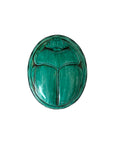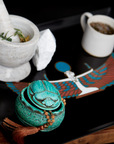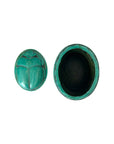Khepri, represented as a scarab (dung beetle), portrays the eternal cycle of life as a symbol of rebirth, regeneration, new beginnings and protection. The name "Khepri" comes from the Egyptian word "kheper", which means "to become" or "to transform".
The scarab was seen as an earthly symbol of this heavenly cycle of sun and revivification which epitomized the dung beetle's behavior as it rolls dung into a ball for the purposes of eating and laying eggs which are later transformed into larva or life. This cycle of the sun rising and setting closely parallels the pattern of birth, life, and death, and then resurrection. In ancient Egypt, the sun was believed to die each day and be reborn each morning. Khepri helped to bring about the dawn each day by rolling the sun across the sky.
The scarab beetle was also seen as a symbol of transformation and regeneration, as it emerged from underground after being buried as a larva. As such, Khepri was a mighty figure of resurrection and change.
Scarab amulets were widely used in ancient Egypt as powerful and transformative symbols, representing renewal and new beginnings. They were believed to offer protection and good luck to the wearer, and could also help to ensure a safe journey through the afterlife.
Khepri, represented as a scarab (dung beetle), portrays the eternal cycle of life as a symbol of rebirth, regeneration, new beginnings and protection. The name "Khepri" comes from the Egyptian word "kheper", which means "to become" or "to transform".
The scarab was seen as an earthly symbol of this heavenly cycle of sun and revivification which epitomized the dung beetle's behavior as it rolls dung into a ball for the purposes of eating and laying eggs which are later transformed into larva or life. This cycle of the sun rising and setting closely parallels the pattern of birth, life, and death, and then resurrection. In ancient Egypt, the sun was believed to die each day and be reborn each morning. Khepri helped to









